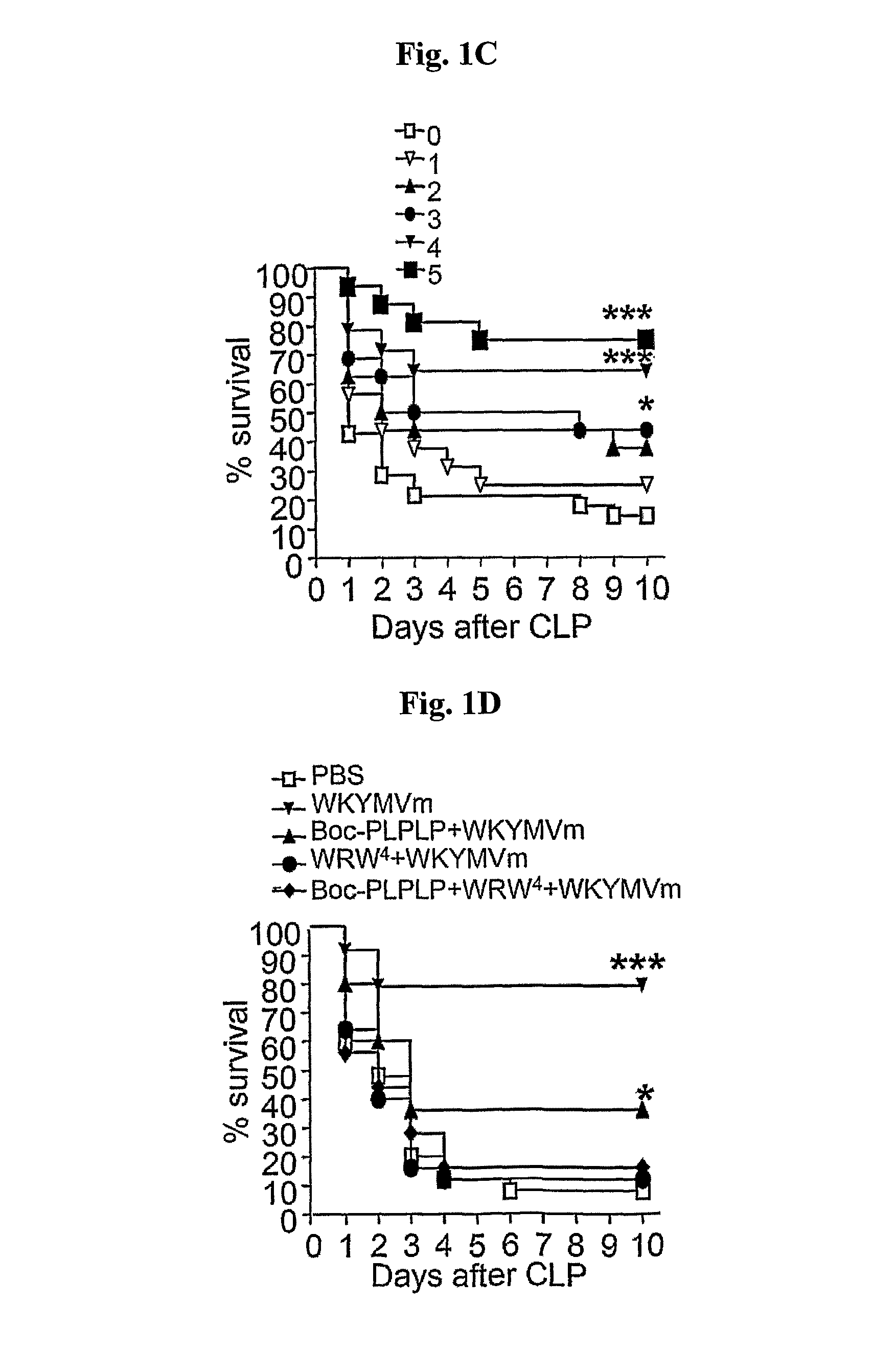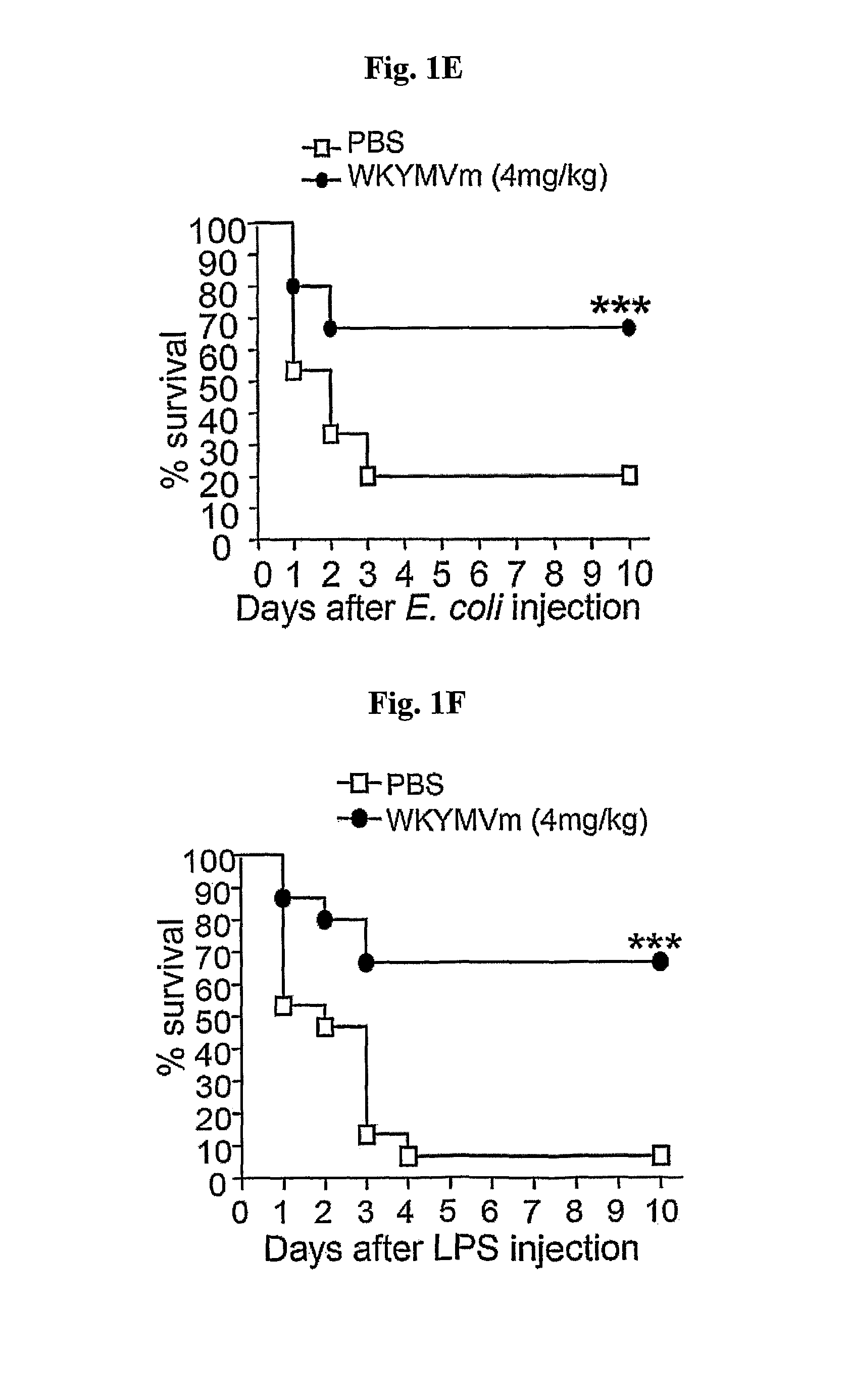Composition and method for preventing and treating immune-related disorder
a technology of immune-related disorders and compounds, applied in the field of immune-modulating agents, can solve the problems of inability to regulate the inflammatory response, clinical signs of multi-organ failure, and controversial therapeutic interventions, and achieve novel and efficient treatments, prevent the effect of clp-induced lethality and effectively prevent the progression to severe sepsis
- Summary
- Abstract
- Description
- Claims
- Application Information
AI Technical Summary
Benefits of technology
Problems solved by technology
Method used
Image
Examples
example 1
COMPARTIVE EXAMPLE 1
[0049]Comp 1-1. Therapeutic Effect of WKYMVm on Other FPR Ligands
[0050]Because WKYMVm is reported to bind FPR family receptors, the therapeutic effect of other FPR ligands was also evaluated. The therapeutic effect of Trp-Lys-Tyr-Met-Val-Met (WKYMVM) (SEQ ID NO:14) (Baek, S. H., et al., J. Biol. Chem. 271:8170-8175), N-formyl-Met-Leu-Phe (fMLF) (SEQ ID NO:15), and MMK-1 peptide (LESIFRSLLFRVM) (SEQ ID NO: 16) (Klein, C., et al., Nat. Biotechnol. 16:1334-1337) was lower than that of WKYMVm (FIG. 1g).
[0051]Moreover, the inactive scrambled peptide Val-Trp-Met-Tyr-D-Met-Lys (VWMYmK) (SEQ ID NO:17) had no therapeutic effect (FIG. 1G). FPR-family agonists (WKYMVm (SEQ ID NO:1), WKYMVM(SEQ ID NO:14), fMLF(SEQ ID NO:15) and MMK-1 (SEQ ID NO:16)) or scrambled peptide (VWMYmK: SEQ ID NO: 17) (4 mg / kg, respectively) were injected subcutaneously four times to CLP mice at 2, 14, 26, and 38 h post-CLP.
[0052]Comp 1-2. Therapeutic Effect of WKYMVm Analogs
[0053]To investigate whe...
example 2
[0054]WKYMVm-Enhanced Survival is Associated with Decrease in Bacterial Colony Counts, Splenocyte Death, and Lung Inflammation
[0055]2-1. Bactericidal Activity
[0056]Because CLP-induced lethality was significantly associated with bacterial colony counts in the peritoneal fluid, the experiment investigated whether FPR activation by WKYMVm affected bacterial clearance from peritoneal fluid. WKYMVm treatment dramatically reduced the intraperitoneal bacterial colony count by 99.8% 24 h after CLP (FIG. 2a). WKYMVm (4 mg / kg) was injected subcutaneously four times into CLP mice 2 and 14 h post-CLP. Peritoneal lavage fluid collected 24 h after sham, CLP or CLP+WKYMVm administration was cultured overnight on blood-agar base plates at 37° C.; the number of CFUs was then counted.
[0057]2-2. Inhibition of Lymphocyte Apoptosis
[0058]Given the observation that sepsis induces extensive lymphocyte apoptosis (Ayala, A., et al., Blood. 87:4261-4275), the experiment also evaluated whether WKYMVm could pre...
example 3
[0063]WKYMVm Enhances Bacterial Clearance and Hydrogen Peroxide Generation in Phagocytes
[0064]To determine whether WKYMVm treatment increases bactericidal activity in vitro, mouse neutrophils were allowed to ingest E. coli for 1 h and were then stimulated with 0.1-1000 nM WKYMVm for 20 min. Such treatment markedly enhanced the bactericidal activity of the neutrophils in a dose-dependent manner (FIG. 3a). Adherent neutrophils were incubated with 106 opsonized E. coli for 1 h, and stimulated with vehicle (PBS) or WKYMVm (0.1, 1, 10, 100, and 1000 nM) for 1 h.
[0065]Because FPR1 and FPR2 are expressed in neutrophils (data not shown), this experiment investigated the roles of FPR1-1 and FPR2-mediated pathways in WKYMVm-induced bactericidal activity. Neutrophils pre-treated with Boc-PLPLP or WRW4 before WKYMVm treatment had significantly inhibited bactericidal activity (FIG. 3b). Mouse neutrophils were isolated from peripheral blood using a Histopaque-1077 solution (Sigma) as described pr...
PUM
| Property | Measurement | Unit |
|---|---|---|
| /D weight ratio | aaaaa | aaaaa |
| W/D weight ratio | aaaaa | aaaaa |
| body weight | aaaaa | aaaaa |
Abstract
Description
Claims
Application Information
 Login to View More
Login to View More - R&D
- Intellectual Property
- Life Sciences
- Materials
- Tech Scout
- Unparalleled Data Quality
- Higher Quality Content
- 60% Fewer Hallucinations
Browse by: Latest US Patents, China's latest patents, Technical Efficacy Thesaurus, Application Domain, Technology Topic, Popular Technical Reports.
© 2025 PatSnap. All rights reserved.Legal|Privacy policy|Modern Slavery Act Transparency Statement|Sitemap|About US| Contact US: help@patsnap.com



